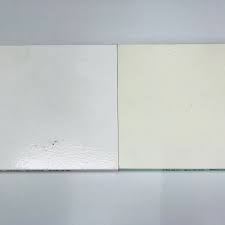How You First Notice Paint Yellowing
It usually becomes most noticeable when you go to touch up or paint a new area close by. You will see over time that your nicely coated oil based enamel finish has become an old antique yellow colour. It's very common and will happen particularly if the areas are in a dark room with not much natural light. We often try to match old enamel colours for our customers and are still presented with an aged colour that has gone sometimes two or three times darker. Watch Video Here
When you compare this old painted colour to the existing colour swatch it will be quite different. The most successful solution is to repaint rather than touch up. Even with our computer colour matching system, we can have variations.
This will only happen with OIL BASED ENAMELS NOT WITH WATER BASED ENAMELS.
So Why Does It Happen & Why Does Paint Yellow?
Oil based enamel paint contain an alkyd resin which partly consists of an oil from a natural source, such as vegetable oils. Oil based enamels are still used in areas
around the home like skirting boards, cabinets and doors, due to the good gloss and appearance, block resistance and hard wearing characteristics. This toughness comes from the curing reaction of the oil with oxygen from the atmosphere over a long period of time. One effect of the curing cycle of the oil
is yellowing, which occurs normally and increases over time. This yellowing is particularly noticeable in clear varnishes and white or light coloured paints. The yellowing of oil based enamel paints has been established for decades and is widely known in the painting industry.
All oil based enamel paints will yellow over time, however there are factors which can accelerate and make this yellowing significantly worse, particularly in the first few months after the paint has been applied. It is known that after an oil based paint has been applied, if the temperature is low and the humidity high and if it is exposed to ammonia, the level of yellowing of the dry film will be higher than
standard. The two most significant sources of ammonia causing the yellowing of the oil based enamel are water based acrylic paints and cleaning products.
The other factor known to accelerate yellowing of oil based enamels is a low level of either natural or artificial light. This is known as dark yellowing. This can occur in areas like the inside of cupboards, behind doors that are kept open (such as cavity doors slid permanently into the cavity) or wherever the dry coating is permanently shaded. Unlike exposure to ammonia, dark yellowing can be reversed by exposing the yellowed enamel to sunlight.
How to avoid or minimalise yellowing.
All oil based enamel paints will yellow over time, Haymes Paint recommends the following to minimise excessive yellowing, particularly in white or pale coloured oil based paints:
(1) Do not apply the oil based enamel when the humidity is high and the temperature is low as the curing of the product will be affected.
(2) Ensure good ventilation and natural light in the area where the oil based enamel is being applied to ensure good curing of the film and avoiding the potential for dark yellowing.
(3) Common paint industry practice is to apply enamels to doors and trim areas prior the application of the broadwall areas with water based acrylic paints. If this process is followed, the enamel paint must be allowed to cure for at least 48 hours, with the rooms being well ventilated, prior to the application of the water based broadwall paints. Best practice is to apply the oil based enamel after the water based acrylic paint. Allow the water based paint to dry for at least 48 hours and up to two weeks in a well ventilated area prior to applying the oil based enamel.
(4) Avoid using cleaning products with high levels of ammonia around oil based enamel paints that have been recently applied. You can determine if the cleaning product contains ammonia by reading the label section of the cleaning product that lists the ingredients.
(5) Avoid applying oil based enamels to surfaces where there is going to be little to no light and do not keep doors or other areas painted in oil based enamel permanently open or shaded, e.g. cavity doors permanently slid into the cavities or internal doors left permanently open.
How to rectify or reverse the yellowing of the oil based paint.
If the yellowing of the oil based enamel was due to the absence of natural light, then the yellowing can be reversed over time by exposing the paint work to light. This reversal is not instantaneous and depending on the light level in the room could take some time. If the yellowing of the oil based enamel is due to poor ventilation and exposure to ammonia, then the enamel should be allowed to cure sufficiently, then lightly sanded and repainted with a non-yellow water based acrylic enamel product like Haymes Ultratrim Acrylic Enamel High Gloss or Semi Gloss.
What's the alternative to oil based enamels that might yellow over time?
If an area such as a door or skirting is going to be painted with a white or pale colour and colour and yellowing is an issue, then water based acrylic enamel technology like Haymes Ultratrim Acrylic Enamel High Gloss and Semi Gloss can be used as an alternative to the oil based products. The alternative to the oil based clear is Haymes Aqualac GP Clear. These are acrylic paints will not yellow like the oil based enamel products.
Haymes Paint has an ongoing development process in the area of trim products to ensure products with excellent film toughness and low yellowing.

